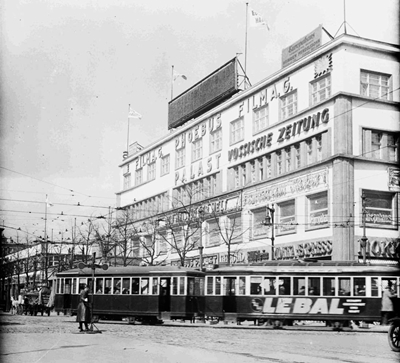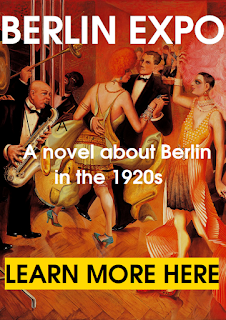Beba-Palast (Atrium): located in the southwest Berlin district of Wilmersdorf, at the corner of Bundesallé (ex Kaiserallé) and Berlinerstrasse. Opened in 1926, this large premiere theater had a magnificent façade which curved around the corner, with the Colisseum in Rome as inspiration source. It was designed by architect Friedrich Lipp, and had 2.025 seats made of mahogany and covered with cardinal red fabric. There was a lighted dome over the hall. The name "Beba" was an acronym of Berliner-Babelsbergerstrasse, a nearby corner where a smaller cinema with the same owner had stood before.
 |
Situation of the cinemas named in this blog
|
1. Ufa palast am Zoo, 2. Gloria-Palast 3. Capitol am Zoo, 4. Marmorhaus, 5.Filmbühne Wien, 6. Ufa Pavillon am Nollendorfplatz, 7. Mozartsaal,YY 8. Tauentzienpalast, 9. Prinzess, 10. Primus-Palast, 11. Kammerlichtspiele in Haus Vaterland, 12. Universum, 13. Phoebus-Palast, 14. Union-Theater Unter den Linden, 15. Piccadilly, 16. Mercedes-Palast, 17. U.T. Lichtspiele Theater am Alexanderplatz, 18. Ufa-Theater Turmstrasse, 19. Lichtburg, 20. Beba-Palast (Atrium), 21. Titania-Palast
Filmbühne Wien (Ufa-Theater Kurfürstendamm, Union-Palast Kurfürstendamm, UT-Lichtspiele).


Called Union-Palast, it opened in 1913 at Kurfürstendamm 26. It was built in the style of Wilhelminian classicism; a temple-like facade with ionic columns and gables. It was one of the first Berlin theaters designed specifically for showing film and it had a café on the ground-floor. The cinema, seating 850, belonged to the UFA from 1924 and has hosted a great number of film premieres. In 1945 the name was changed to Filmbühne Wien.
Ufa-Theater Turmstrasse


In Moabit, Turmstrasse 25-26 at the corner of Stromstrasse. The UFA-Theater, designed by Max Bischoff after American standards, had room for 1700 visitors. In addition to an organ there was also an orchestra pit. A light source enhanced the atmosphere of the film during the screening, so that the auditorium could be bathed in white, blue, red or violet light. Neo-Classical exterior, Art Deco interior. There was also a café with a stage for an orchestra. The name of the café seems to have been Vaterland (not to mix up with the Haus Vaterland by Potsdamer Platz.)
UFA, which already owned three premiere cinemas around the Kaiser Wilhelm Memorial Church (Gedächtniskirche) in the heart of West Berlin, took the somewhat risky decision to settle in Moabit, a densely populated area to the North that had previously lacked a modern cinema.
Tauentzienpalast

It was a large cinema with a spacious café at Nürnberger Straße 57-59, at the corner of Tauentzienstrasse, in what today is the district of Schöneberg. The building was adjacent to the well known Femina Palace, designed in an avant-garde style known as Neue Sachlichkeit. Close to the famous KaDeWe department store, it was one of the largest premiere cinemas run by the UFA, along with the nearby Ufa-Palast am Zoo and Gloria-Palast. The cinema boasted the largest organ in Europe and it enjoyed air conditioning that blew eau de cologne into the auditorium.
At first called Kammerlichtspiele, the theater opened in 1913 with 1200 seats as a subsidiary establishment – on the ever busy Tauentzienstrasse – to the one with the same name on Potsdamer Platz. A little later the name was changed to Tauentzienpalast. In 1920 the UFA took it over. Iconic films such as Walther Ruttmann's Berlin – The Symphony of the Big City (1927) or I Kiss Your Hand, Madame (1929) with Marlene Dietrich and Richard Tauber premiered here.
Lichtburg

Lichtburg, that means something like Castle of Light, was built by the architect Rudolf Fränkel in 1929 in a stunning Art Deco/Moderne style as part of the new garden-city Atlantic. Located in the north-east Berlin district of Wedding, at the corner of Behmstrasse and Heidebrinker Strasse, it could seat 2.300 in all. It was the first building to break with the straight lines which had hitherto been almost compulsory for any architect attempting to innovate.The outstanding element was the 40-meter-high round tower. The tower had space for events with up to 700 people, but it hosted also lighting gear which made the cinema visible from afar. In the glass roof pavilion, three searchlights with 1500 watt lamps rotated and shone into the sky, while around 1000 lamps illuminated the 15 vertical windows made of opal glass : it was like a lighthouse beam on top of the building. The Lichtburg is the first cinema in Berlin after which a street, the Lichtburgring, was named.
U.T. Lichtspiele Theater
On the Alexanderplatz, in the east of Berlin. It was enormous in comparison to its predecessors. It was created out of drastic rebuilding of the Grand Hotel Alexanderplatz in 1909 and was refurbished and enlarged once more in 1914. It had 1.055 seats and the effect of the interior was impressive, even if the architecture was relatively simple, probably thanks to rich painting at very little cost.
The original address was Alexanderstrasse 46-48, renumbered 5-7 in 1934. In 1924 the cinema it was renamed Ufa Lichtspiele Alexanderplatz.
Kammerlichtspiele im Haus Vaterland
This cinema has also been known as Ufa-Haus am Potsdamer Platz. Its auditorium was strikingly modern, on a circular plan and with red carpeting and gold-painted wooden trim on the 1.400 seats. The theater was hosted in one of the upper floors of the famous Haus Vaterland.
Phoebus Palast
 |
| Phoebus-Palast |
The Phoebus-Palast was renamed Emelka Palast in 1932. It was hosted close to the Anhalter Bahnhof, in the ultra-modern Europa-Haus, at the corner of Königgrätzer Strasse (today Stresemannstrasse) and Anhalterstrasse. It had 1.840 seats and possessed all contemporary technical innovations. There were spotlights in various places and strengths, so that the house could also be used for revues or operettas in the summer. It had a double front on Anhalter and Königgrätzer Strasse.
Some other Berlin cinemas in the Weimar years:
Union-Theater - Unter den Linden, at Unter den Linden 21 (today 39)
Primus-Palast (Biophon-Theater-Lichtspiele) on Potsdamer Strasse at the corner of the no longer existing Margarethenstrasse, a bit SW of Potsdamer Platz.
Prinzess Theater
Kantstrasse 163, between Kaiser-Wilhelm-Gedächtniskirche and Joachimsthaler Strasse
Two cinemas built by Fritz Wilms:
Piccadilly, on Bismarckstrasse 93, near Deutsche Oper
Mercedes-Palast, in Neukölln, on Hermannstrasse 214-216 at the corner of Rollbergstrasse, a bit east of Tempelhofer Feld.



















































